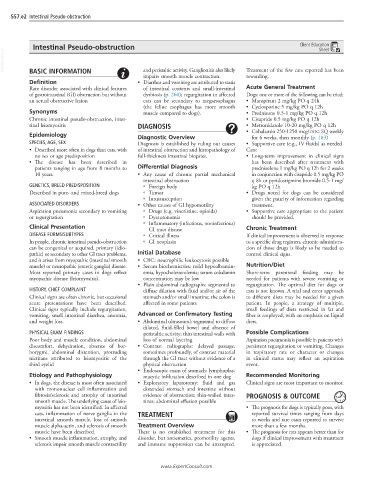Page 1118 - Cote clinical veterinary advisor dogs and cats 4th
P. 1118
557.e2 Intestinal Pseudo-obstruction
Intestinal Pseudo-obstruction Client Education
Sheet
VetBooks.ir
BASIC INFORMATION
and peristaltic activity. Ganglionitis also likely
impairs smooth muscle contraction. Treatment of the few cats reported has been
rewarding.
Definition • Diarrhea and vomiting are attributed to stasis
Rare disorder associated with clinical features of intestinal contents and small-intestinal Acute General Treatment
of gastrointestinal (GI) obstruction but without dysbiosis (p. 260); regurgitation in affected Dogs: one or more of the following can be tried:
an actual obstructive lesion cats can be secondary to megaesophagus • Maropitant 2 mg/kg PO q 24h
(the feline esophagus has more smooth • Cyclosporine 5 mg/kg PO q 12h
Synonyms muscle compared to dogs). • Prednisone 0.5-1 mg/kg PO q 12h
Chronic intestinal pseudo-obstruction, intes- • Cisapride 0.5 mg/kg PO q 12h
tinal leiomyositis DIAGNOSIS • Metronidazole 10-20 mg/kg PO q 12h
Epidemiology Diagnostic Overview • Cobalamin 250-1250 mcg/DOG SQ weekly
for 6 weeks, then monthly (p. 183)
SPECIES, AGE, SEX Diagnosis is established by ruling out causes • Supportive care (e.g., IV fluids) as needed
• Described more often in dogs than cats, with of intestinal obstruction and histopathology of Cats:
no sex or age predisposition full-thickness intestinal biopsies. • Long-term improvement in clinical signs
• The disease has been described in has been described after treatment with
patients ranging in age from 8 months to Differential Diagnosis prednisolone 1 mg/kg PO q 12h for 2 weeks
10 years. • Any cause of chronic partial mechanical in conjunction with cisapride 0.5 mg/kg PO
intestinal obstruction q 8h or pyridostigmine bromide 0.5-1 mg/
GENETICS, BREED PREDISPOSITION ○ Foreign body kg PO q 12h
Described in pure- and mixed-breed dogs ○ Tumor • Drugs noted for dogs can be considered
○ Intussusception given the paucity of information regarding
ASSOCIATED DISORDERS • Other causes of GI hypomotility treatment.
Aspiration pneumonia secondary to vomiting ○ Drugs (e.g. vincristine, opioids) • Supportive care appropriate to the patient
or regurgitation ○ Dysautonomia should be provided.
○ Inflammatory (infectious, noninfectious)
Clinical Presentation GI tract disease Chronic Treatment
DISEASE FORMS/SUBTYPES ○ Critical illness If clinical improvement is observed in response
In people, chronic intestinal pseudo-obstruction ○ GI neoplasia to a specific drug regimen, chronic administra-
can be congenital or acquired, primary (idio- tion of those drugs is likely to be needed to
pathic) or secondary to other GI tract problems, Initial Database control clinical signs.
and it arises from myopathic (intestinal smooth • CBC: neutrophilic leukocytosis possible
muscle) or neuropathic (enteric ganglia) disease. • Serum biochemistries: mild hypoalbumin- Nutrition/Diet
Most reported primary cases in dogs reflect emia, hypocholesterolemia; serum cobalamin Short-term parenteral feeding may be
myopathic disease (leiomyositis). concentration may be low needed for patients with severe vomiting or
• Plain abdominal radiographs: segmental to regurgitation. The optimal diet for dogs or
HISTORY, CHIEF COMPLAINT diffuse dilation with fluid and/or air of the cats is not known. A trial and error approach
Clinical signs are often chronic, but occasional stomach and/or small intestine; the colon is to different diets may be needed for a given
acute presentations have been described. affected in some patients patient. In people, a strategy of multiple,
Clinical signs typically include regurgitation, small feedings of diets restricted in fat and
vomiting, small intestinal diarrhea, anorexia, Advanced or Confirmatory Testing fiber is employed, with an emphasis on liquid
and weight loss. • Abdominal ultrasound: segmental to diffuse diets.
dilated, fluid-filled bowel and absence of
PHYSICAL EXAM FINDINGS peristaltic activity; thin intestinal walls with Possible Complications
Poor body and muscle condition, abdominal loss of normal layering Aspiration pneumonia is possible in patients with
discomfort, dehydration, absence of bor- • Contrast radiographs: delayed passage, persistent regurgitation or vomiting. Changes
borygmi, abdominal distention, protruding sometimes profoundly, of contrast material in respiratory rate or character or changes
nictitans attributed to leiomyositis of the through the GI tract without evidence of a in clinical status may reflect an aspiration
third eyelid physical obstruction event.
• Endoscopic exam of stomach: lymphoplas-
Etiology and Pathophysiology macytic infiltration described in one dog Recommended Monitoring
• In dogs, the disease is most often associated • Exploratory laparotomy: fluid and gas Clinical signs are most important to monitor.
with mononuclear cell inflammation and distended stomach and intestine without
fibrosis/sclerosis and atrophy of intestinal evidence of obstruction; thin-walled intes- PROGNOSIS & OUTCOME
smooth muscle. The underlying cause of leio- tines; abdominal effusion possible
myositis has not been identified. In affected • The prognosis for dogs is typically poor, with
cats, inflammation of nerve ganglia in the TREATMENT reported survival times ranging from days
intestinal smooth muscle, loss of smooth to weeks and rare cases reported to survive
muscle alpha-actin, and sclerosis of smooth Treatment Overview more than a few months.
muscle have been described. There is no established treatment for this • The prognosis for cats appears better than for
• Smooth muscle inflammation, atrophy, and disorder, but antiemetics, promotility agents, dogs if clinical improvement with treatment
sclerosis impair smooth muscle contractility and immune suppression can be attempted. is appreciated.
www.ExpertConsult.com

